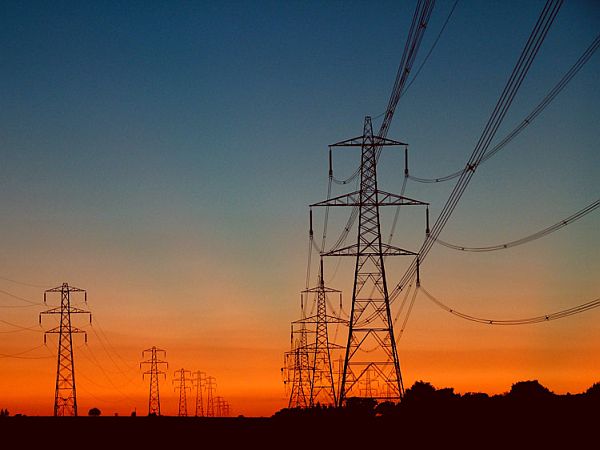 An electrical grid is the network of power transmission lines and substations that deliver power generated in a power plant to your home or workplace. Typically , the power generated in a power plant is stepped up to high voltages of about 220 kilovolts ( kV) or higher even up to 1000 kV that is sent over transmission lines across the country. The high transmission voltages reduce energy losses. Close to the point of use, these voltages are stepped down in substations to voltage levels that we use .
An electrical grid is the network of power transmission lines and substations that deliver power generated in a power plant to your home or workplace. Typically , the power generated in a power plant is stepped up to high voltages of about 220 kilovolts ( kV) or higher even up to 1000 kV that is sent over transmission lines across the country. The high transmission voltages reduce energy losses. Close to the point of use, these voltages are stepped down in substations to voltage levels that we use .
The present electrical grid is essentially designed as a one-way street , to deliver the power generated at the power station to your home or workplace. Over the past 100 years of growth and development of the electrical grid , features have been added to permit interconnection of regional grids so that in the event of overload or outage in one region, power can be drawn from another region. The grids have also been fitted with better protective relays that are able to predict unsafe conditions and isolate the sections of the grid that have the problem so that power supply can be maintained in the healthy sections of the grid.
A more recent development is the so called “time-of-day tariff”. Since the energy demand during a day and over the seasons vary, power companies offer lower rates at off-peak periods to consumers to encourage peak-shaving of power demand. The energy meters that are used to measure and bill the user have now evolved to be able to handle these varying tariffs and have evolved into what are being called Smart Meters. The present day grid also has not taken into account the coming on-line of small alternative energy sources such as Wind and Photovoltaics which are often owned by the power consumers themselves.
The Smart Grid
The US Government in 2009 adopted a document named “A Policy Framework for the 21st Century Grid” with the goal to modernize the electric power grid. The plan is to incorporate technologies already developed and in use in other industries to bring about a quantum jump in power supply reliability. A study by Berkeley Labs says that power outages cost the US economy some $ 80 billion a year. Other researchers suggest the loss is even higher.
A study by the respected Electrical Power Research Institute ( EPRI ) estimates the Smart Grid project to deliver $1.3 to 2 trillion in benefits over the next 20 years. If these numbers are anywhere close to reality, the Smart Grid will have the transfomational impact that the laying of railrods and the construction of interstate highways had for our previous generations. The Smart Grid could also become the platform for a whole new range of products and services much like the Internet has become for our generation.
The trends
Some examples of the work being done towards furtherance of the Smart Grid technologies are given below as trends to the future.
1.Singapore begins work on 1 MW Smart Grid for Jurong Island
Singapore already has one of the most reliable electricity grids in the world with average outage time reduced to 0.3 minutes per customer per year. This is down from nearly 4 minutes per customer per year a decade ago, a level not achieved even today in many parts of the world.
Despite this , the Energy Market Authority of Singapore has launched this pilot project as a “living laboratory” to gain experience with Smart Grids and to develop new applications that can be tried out. For example, besides installing over 4000 smart energy meters, households have been provided with a pager-like device that tells the consumer his energy consumption in real time instead of waiting for the month-end bill. Early results show that this awareness has led to the adoption of voluntary energy saving measures.
The consumer is free to choose his electricity retailer and the monthly energy usage plan much like a cell phone user. Many of the retailers are bundling related services like Building Management Services and Home Automation services into their energy retail plans to bring additional benefits to the consumer.
In the next phase , the plan is to integrate consumer owned power generating devices like stand-by generators or photovoltaics or even electric or hybrid cars into the Smart Grid. The grid will permit these to plug into the grid and earn revenue depending on the time of day.
2. Smart Grid ready domestic appliance
Miele, the German manufacturer of appliances announced a Washer-Dryer at the IFA Berlin show in Sept 2010 that will turn itself on to operate when the elctricity tariffs are the lowest. The appliance is equipped with a gateway communications module that will monitor power tariffs on the internet. This module will also communicate with the owner of the appliance through his mobile phone or other device to notify him of any problems such as machine breakdown. This kind of functionality, could well become the norm for domestic appliances once the Smart Grid gets rolled out.
3. A new chip for the Smart Grid

EPFL , the Lausanne based Swiss teaching and research school has announced the development of a new chip that can be retrofitted into an existing grid to serve as sensor and controller. This 4 mm chip is said to be 1000 times faster for this application than existing general purpose chips . Researchers at EPFL say that the biggest challenge in the present grid is that a fault event is sensed only after it has occurred which means that an interruption of service is always caused.
With this chip , they claim that continuous monitoring of the grid parameters in real time would enable prediction of the fault before it occurs. The chip can be programmed specific to each grid where it is deployed. This development was part funded by ABB which has now applied for a patent. EPFL has chosen a small town Al Hamra , near Ras al Kheima in the UAE to deploy these chips on a pilot scale. Commercial availability may be some 5 years away .
The benefits
The deployment of the Smart Grid does promise to move the electricity industry to a new growth path of increased reliability, self healing in the event of disruption, two way communication with the consumer and the ability to integrate new and non-conventional energy sources like wind or photovoltaics seamlessly into the grid.
With increased reliability, it is estimated that increases to power generation capacity in the US could be limited to 0.7% per year in place of the 3-4% of “just-in-case” additions that happen at present. The spawning of new devices like the smart appliances will contribute to a more energy efficient world. New trends like using the batteries of an electric car as energy storage devices to store energy from off-peak hours and feed to the grid at peak hours would begin.
The lowdown
The Smart Grid roll out in the US is estimated to cost between $13 and $ 50 billion. Only $4.5 billion has been committed in federal funds. Similar sums would be needed in other parts of the world from increasingly money strapped governments. Another major concern is that the smart grid will drive the energy costs for peak hours too high for the poorer sections of the population to afford, what for them would be essential supplies that cannot be deferred.
The Impact
The Smart Grid is an exciting new development with the possibility of major transformation of our lives. This will also bring forth many new innovations that could lead to changes in the way we receive and use electricity.




